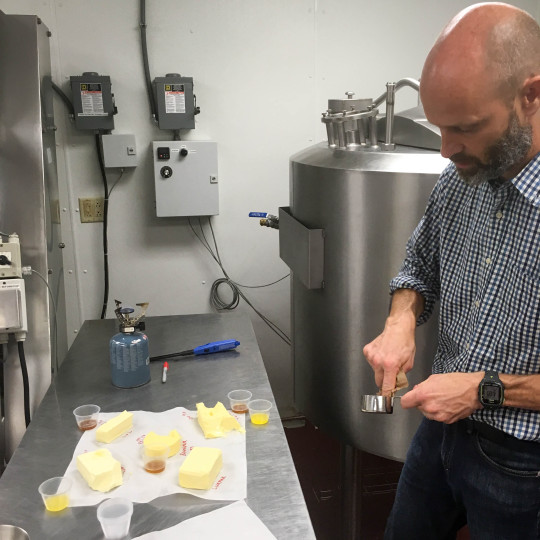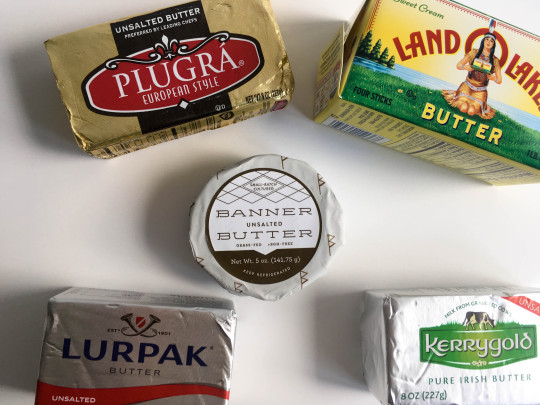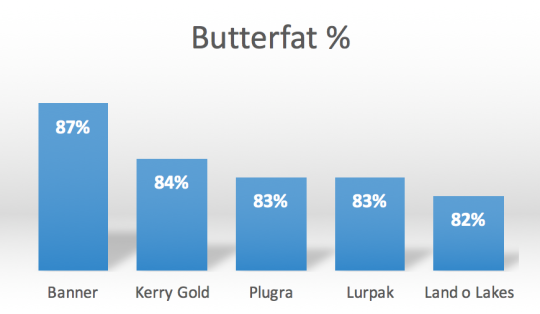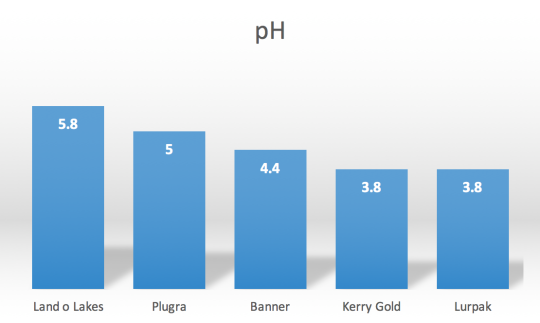An assessment of acidity and butterfat for a few premium butters by Chief Butter Professional, Drew.

For butter nerds, comparisons of butter attributes across brands is de rigueur conversation. Being butter nerds ourselves, we felt it necessary (nay interesting and fun) to run our own comparison. We grabbed several big butter brands yesterday and set them up inside our production kitchen to check them out.

Despite the long tradition of judging standards for butter and accepted measurements for things that make butter, well, truly butter; many elements like appearance, taste, and texture are subjective. We’re obviously biased, so I’ll just focus on a quantitative measure in the analysis – the proportion of butterfat.*
Butterfat is easily measured via the modified Kohman Method (basically weighing butter samples before and after burning off water). Before we get to the data, a little background on butterfat. Most commodity butter sold in the US is 80-82% butterfat. The overall composition breaks down as 82% fat, 16% water, and 2% solids.
More butterfat in your butter means:
• Silkier texture, better flavor (when present) – butterfat is a wonderful delivery mechanism for flavor because of its melting properties. More butterfat means the flavor in the cream or other ingredients in the butter, like our Cinnamon Cardamom Ginger butter, is enhanced.
• Higher smoke point – less water means the butter becomes a better medium for sautéing and searing.
• Flakier, lighter pastries – higher fat means that it keeps it structure better when mixing, allowing for more air pockets when the dough is ultimately baked.
pH is a measure of acidity. With more acidity there is more lactic acid, which creates much of the flavor in butter. Plugra and Land O’Lakes are essentially sweet cream butters, meaning pasteurized cream is immediately churned into butter without culturing. Both of these sweet cream brands have “Natural Flavorings” or “Lactic Acid” in their ingredients. If they left it out, their butter wouldn’t taste like anything. By contrast, Banner Butter is slow cultured by adding a mix of cultures to heavy cream over 36 hours – the luscious butter flavor is developed naturally over time, not added.
Kerry Gold and Lurpak are also billed as cultured butters, although in Europe some cultured butters are essentially sweet cream butters that are sprayed with a liquid mixture of live cultures after churning. This allows them to avoid the use of “natural flavorings” on their labels”. See the NIZO method here.

On to the results…
Butterfat Percentage:

Our batch-churning process gives Banner the highest butterfat percentage! Good for your body and better taste.
pH:

Land O’Lakes, being a sweet cream butter, shows the highest pH (less lactic acid, closer to sweet cream). Plugra, while a sweet cream butter, must add some amount of lactic acid, which is pushing down the pH and the acidity up. I’m not sure if either Kerrygold or Lurpak uses the weird NIZO method I mentioned above, but their unusually low pH raises questions.
So there you have it – our back-of-the-envelope, not-so-scientific assessment of acidity and butterfat for a few premium butters. Beyond charts and graphs, butterfat and pH, we suggest you TASTE Banner for yourself. We think you’ll like it!
*Sorry, but I can’t help it. Our taste testers (me and Millie) affirmed that Banner Butter has the best taste and texture. The other butters tasted “brassy”, “ok, I guess,” and in one case “can I have some water now?”